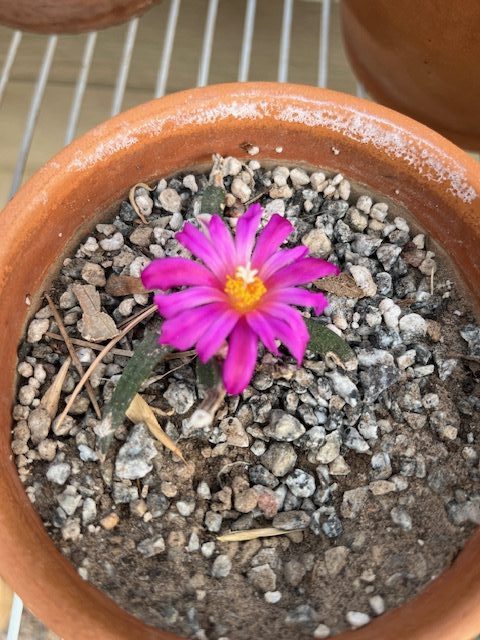I had been watching my Ariocarpus bravoanus for several days anxiously waiting for it to bloom. Then on Tuesday (October 22), there it was!
You can see some of the plant in this picture.
The next day the Ariocarpus agavoides next to the bravoanus also opened. You have to look closely, but the bravoanus has paler petals behind the top layer of darker pitals and the bravoanus just has one layer of petals. You also have to look closely to see the body of the plants are different, the leaves are thicker in the bravoanus, and then longer and slightly thinner on the agavoides.
I had noticed a Pleiospilos nelii close by that was showing some yellow, but I didn’t pay much attention to it at the time.
I checked on the flowers the next day and as night fell, I checked again. The ariocarpuses had closed, but nearby the Pleiospilos nelii had opened. I was aware of this plant being an evening bloomer, but had kind of forgotten about it. Shame on me, because it was lovely and the yellow flower really stood out.
Both ariocarpus plants’ blooms reopened for four days each, and I checked on them every day. But then Saturday, I went to the greenhouse on purpose after dark and was greeted by two yellow flowers wide open! These will reopen a couple of evenings in a row.
So, if you buy one of these succulents, be aware that when you see buds forming, like in the picture below, start checking on it as the bud enlarges, and you will be rewarded with a lovely night bloom. My research said that they open in the afternoon and close in the evening. Mine stayed open in the dark.
These ariocarpus are endemic to Mexico and are considered endangered due to collecting and loss of habitat. The agavoides is sometimes even eaten as food, which gives people another reason to harvest them. The pleiospilos is native to South Africa, and I don’t think they are endangered. All three, if bought from a reputable nursery, are good additions to your collection. The ariocarpus are cactus; the pleiospilos is a succulent and all three are slow-growers, so you do have to be patient and read up on their care.
But they are fun plants to have.









Alice I have been to Arizona and Big Bend this year. I love your passion for succlants.
Glad you are a fan!